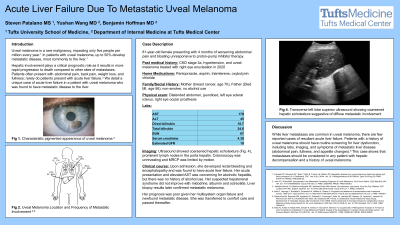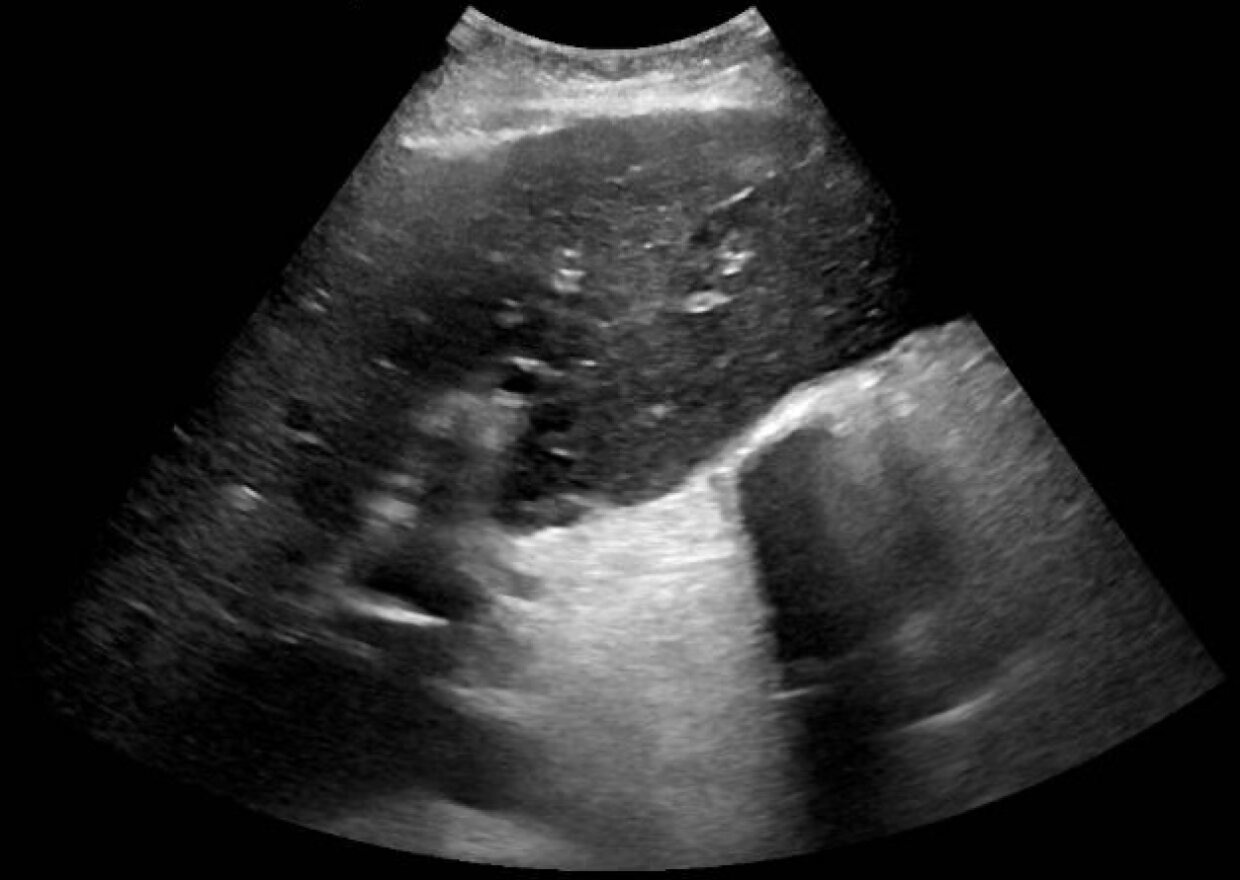Tuesday Poster Session
Category: Liver
P3876 - Acute Liver Failure Due to Metastatic Uveal Melanoma
Tuesday, October 24, 2023
10:30 AM - 4:00 PM PT
Location: Exhibit Hall

Has Audio

Steven Patalano, MS
Tufts University School of Medicine
Boston, MA
Presenting Author(s)
Steven Patalano, MS1, Yushan Wang, MD2, Benjamin Hoffman, MD2
1Tufts University School of Medicine, Boston, MA; 2Tufts Medical Center, Boston, MA
Introduction: Uveal melanoma is a rare malignancy, impacting only five people per million every year. In patients with uveal melanoma, up to 50% develop metastatic disease, most commonly to the liver. Hepatic involvement plays a critical prognostic role as it results in more rapid progression to death compared to other sites of metastases. Patients often present with abdominal pain, back pain, weight loss, and fullness; rarely do patients present with acute liver failure. We detail a unique case of acute liver failure in a patient with uveal melanoma who was found to have metastatic disease to the liver.
Case Description/Methods: The patient was an 81-year-old woman with a history of CKD stage 3a, hypertension, and uveal melanoma treated with right eye enucleation in 2020. She presented with 4 months of worsening upper abdominal pain and bloating that was unresponsive to proton-pump inhibitor therapy. Upon admission, she developed rectal bleeding and encephalopathy and was found to have acute liver failure. She was transferred to our home institution, a tertiary liver center.
During her inpatient stay, her AST peaked at 179, ALT remained normal, direct bilirubin peaked at 18.7, and total bilirubin peaked at 24.6. Her BUN was 67, serum creatinine 4.38, and estimated GFR 10. The following studies were negative: hepatitis panel, monospot, CMV, ANA, AFP, CEA, CA 19-9, alpha-1, ceruloplasmin, and TTG IgA. Computed tomography revealed new hepatomegaly, and small volume ascites. Ultrasound showed coarsened hepatic echotexture, prominent lymph nodes in the porta hepatis. Colonoscopy was unrevealing and MRCP was limited by motion.
Her acute presentation and elevated AST was concerning for alcoholic hepatitis, but there was no history of alcohol use. Her suspected hepatorenal syndrome did not improve with midodrine, albumin and octreotide. Liver biopsy results later confirmed metastatic melanoma. Her prognosis was poor given her multisystem organ failure and newfound metastatic disease. She was transferred to comfort care and passed thereafter.
Discussion: While liver metastases are common in uveal melanoma, there are few reported cases of resultant acute liver failure. Patients with a history of uveal melanoma should have routine screening for liver dysfunction, including labs, imaging, and symptoms of metastatic liver disease (abdominal pain, fullness, and appetite changes). This case shows that metastases should be considered in any patient with hepatic decompensation and a history of uveal melanoma.

Disclosures:
Steven Patalano, MS1, Yushan Wang, MD2, Benjamin Hoffman, MD2. P3876 - Acute Liver Failure Due to Metastatic Uveal Melanoma, ACG 2023 Annual Scientific Meeting Abstracts. Vancouver, BC, Canada: American College of Gastroenterology.
1Tufts University School of Medicine, Boston, MA; 2Tufts Medical Center, Boston, MA
Introduction: Uveal melanoma is a rare malignancy, impacting only five people per million every year. In patients with uveal melanoma, up to 50% develop metastatic disease, most commonly to the liver. Hepatic involvement plays a critical prognostic role as it results in more rapid progression to death compared to other sites of metastases. Patients often present with abdominal pain, back pain, weight loss, and fullness; rarely do patients present with acute liver failure. We detail a unique case of acute liver failure in a patient with uveal melanoma who was found to have metastatic disease to the liver.
Case Description/Methods: The patient was an 81-year-old woman with a history of CKD stage 3a, hypertension, and uveal melanoma treated with right eye enucleation in 2020. She presented with 4 months of worsening upper abdominal pain and bloating that was unresponsive to proton-pump inhibitor therapy. Upon admission, she developed rectal bleeding and encephalopathy and was found to have acute liver failure. She was transferred to our home institution, a tertiary liver center.
During her inpatient stay, her AST peaked at 179, ALT remained normal, direct bilirubin peaked at 18.7, and total bilirubin peaked at 24.6. Her BUN was 67, serum creatinine 4.38, and estimated GFR 10. The following studies were negative: hepatitis panel, monospot, CMV, ANA, AFP, CEA, CA 19-9, alpha-1, ceruloplasmin, and TTG IgA. Computed tomography revealed new hepatomegaly, and small volume ascites. Ultrasound showed coarsened hepatic echotexture, prominent lymph nodes in the porta hepatis. Colonoscopy was unrevealing and MRCP was limited by motion.
Her acute presentation and elevated AST was concerning for alcoholic hepatitis, but there was no history of alcohol use. Her suspected hepatorenal syndrome did not improve with midodrine, albumin and octreotide. Liver biopsy results later confirmed metastatic melanoma. Her prognosis was poor given her multisystem organ failure and newfound metastatic disease. She was transferred to comfort care and passed thereafter.
Discussion: While liver metastases are common in uveal melanoma, there are few reported cases of resultant acute liver failure. Patients with a history of uveal melanoma should have routine screening for liver dysfunction, including labs, imaging, and symptoms of metastatic liver disease (abdominal pain, fullness, and appetite changes). This case shows that metastases should be considered in any patient with hepatic decompensation and a history of uveal melanoma.

Figure: Fig 1. Transverse left lobe superior ultrasound read. Coarsened hepatic echotexture, compatible with cirrhotic change.
Disclosures:
Steven Patalano indicated no relevant financial relationships.
Yushan Wang indicated no relevant financial relationships.
Benjamin Hoffman indicated no relevant financial relationships.
Steven Patalano, MS1, Yushan Wang, MD2, Benjamin Hoffman, MD2. P3876 - Acute Liver Failure Due to Metastatic Uveal Melanoma, ACG 2023 Annual Scientific Meeting Abstracts. Vancouver, BC, Canada: American College of Gastroenterology.
